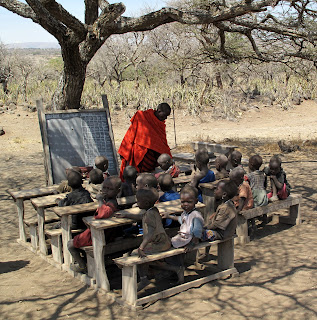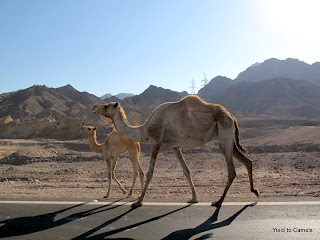I have reached Tanzania via Kenya. My backpack, however, toured Ethiopia by way of a brief stopover in Addis Ababa. It took three days for me to retrieve it, during which time I only had shorts and a tee shirt.
I was fortunate to visit a local village just outside Arusha on my first full day in Tanzania. It is fascinating to see how the people structure their lives in this environment. The average income here is about a dollar per day and many of the people live by barter, farming and animal raising. Families live in small mud huts that house the women, children, goats and cows. The men generally live in a separate dwelling, especially if they have more than one wife. The familys focus on shelter, agriculture, and raising their children. School is supported by the federal government, which provides the teachers. The community, with whatever aid is available, provides the buildings and food. Educational supplies are limited. AIDS is a huge problem here and fills the orphanages with parentless children.
All said, the children and most people I have seen in Tanzania are warm, friendly and joyful.
A few notes on the photos:
The second photo is a picture I have seen around the world - a black plastic bag - they are everywhere, clinging to plants, on roads - everywhere.
The lady cooking meat soup is the local village cafe where the men also drink banana beer.
The next photo is a coffee bush. There are larger coffee plantations, but the villages also grow it to provide some income.
Next is a photo of the local sawmill. Basically a pit where one man holds one end of saw while a guy on top has the other.
Then there is the photo of the PE class at the local high school - farming is their sport.
The last picture is the typical vegetable and bean market in the village. Boys, also take milk down to Arusha by bike and then ride back up - it is steep as this village is on the slopes of Mt. Meru.
There was a bus crash a few days ago. It was a bus between Arusha and Dar. Thirty three people were killed. I was going to go that day, but decided to go to Dar a day early. Unforetunately, I met some people who were going to do that day. I hope they were not on that bus.



 It is true, white men can't jump - or at least this one can't jump like a Masai. A visit to a Boma camp during safari was a treat. These people, like many tribes in Africa, are colorful and interesting. The women build the bomas or houses out of straw, mud and cow dung! The animals come into the small huts to sleep with them at night. Pretty cramped and smelly dwellings. I was truely amazed at the great distances I saw the men walking as they strolled across the plains with their red dress and sticks. In the village, which is several bomas surrounded by an acacia "fence" of thorns, many of the men tried to trade their sticks for my cheap casio watch. What they would do with a watch, I will never know - probably just a status symbol.
It is true, white men can't jump - or at least this one can't jump like a Masai. A visit to a Boma camp during safari was a treat. These people, like many tribes in Africa, are colorful and interesting. The women build the bomas or houses out of straw, mud and cow dung! The animals come into the small huts to sleep with them at night. Pretty cramped and smelly dwellings. I was truely amazed at the great distances I saw the men walking as they strolled across the plains with their red dress and sticks. In the village, which is several bomas surrounded by an acacia "fence" of thorns, many of the men tried to trade their sticks for my cheap casio watch. What they would do with a watch, I will never know - probably just a status symbol.



















































